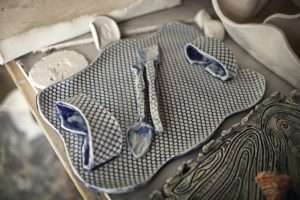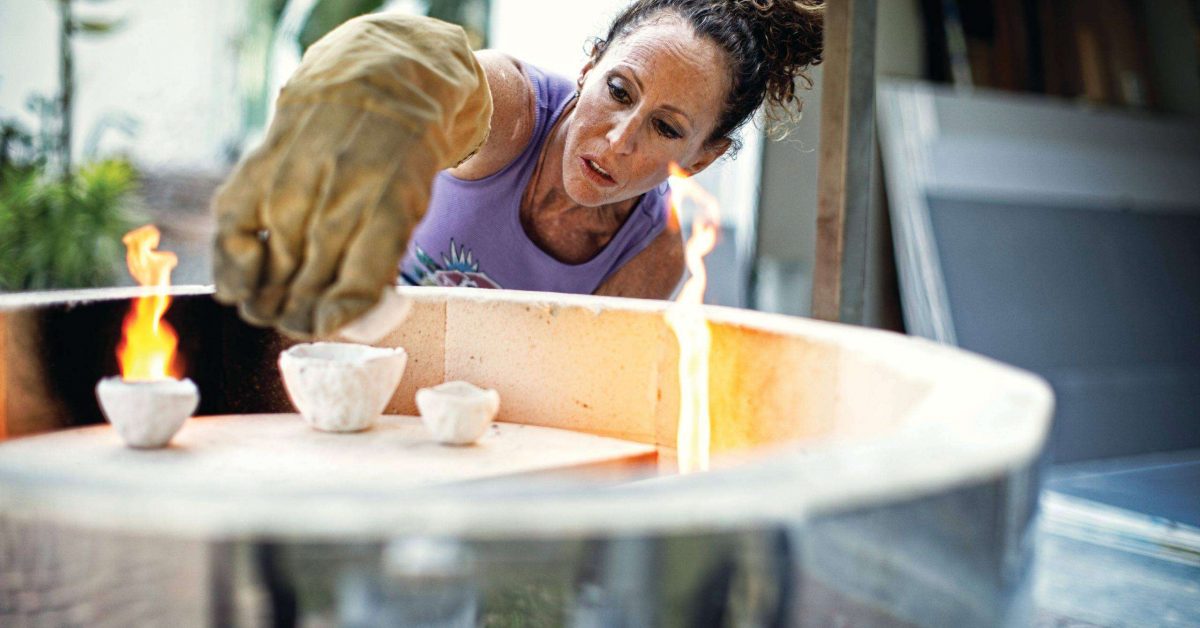Divorce isn’t something many appreciate, but for Tracy Gurdian, the stress, hardship and vulnerability led to finding her passion—and success as an artist.
“That was pivotal,” Gurdian says of her divorce and setting up her business, Tovari Designs. “It was the best thing that could have happened … I would never have found clay, never have had this business, never have focused on my potential.” And never have found her partner of 11 years, John Schrock, who helps with raku, a dangerous Japanese ceramic-firing process.
Gurdian’s art is now sold by luxury retailers, including San Francisco’s Gumps and Manhattan’s Bergdorf Goodman; Curated Kravet, a global furnishings company; and Naples’ Judith Liegeois Designs and Judith’s on Third.
Gurdian’s first passion was modern dance. After graduating from Barron Collier High School, she earned liberal arts and dance degrees, minoring in business, but an injury meant giving up dance. In 1997, married, pregnant and raising a child, she needed a creative outlet. After attending an adult-ed ceramics class for 10 years, someone said her work was gallery level. She took it to a posh local gallery. It sold.
After divorcing, she began transforming her passion into a career. She named Tovari after her daughter, Tova (“everything good and beautiful”), and her son, Ari.
“When I first touched clay, I connected,” she says, adding that she’s inspired by nature and asymmetry. “Although I’m not dancing anymore, I’m choreographing, in clay.”
She specializes in raku, glazed, bisque-fired pottery baked in a glass kiln at 1,800 degrees. It requires two people, wearing fire-resistant gloves. Schrock rolls a glass kiln outside, waits 40 minutes, then lifts a pulley. Gurdian, using long tongs, gently removes the red-hot pottery and places it into a newspaper-filled aluminum can, which bursts into flames. Schrock covers it. They repeat the process until all are burning. After 10 minutes, they lift the lids, and she sprays each with a hose, which can cause cracks.

“My fascination with raku was about no attachments,” she says of the carbon-infused, iridescent pieces. “I love the danger.”
In 2013, she spent a month in Japan learning another process called kintsugi—repairing pottery with gold, transforming flaws.
“Everything I break, I kintsugi,” she says. “My happy accidents often become my best pieces.”
The couple are “huge foodies,” who visit top European restaurants, meeting with chefs. “In Europe, they frequently use handmade pieces to display food,” says Gurdian, who began creating earthenware serving trays, plates and vases.
The distinctive look comes from rolling Italian and French fabrics and ornate lace into wet clay.
One of her staunchest supporters is gallery owner Judith Liegeois, who began carrying her pieces in 2010, drawn by her enthusiasm. “She was intriguing,” Liegeois says, noting she needed to understand Gurdian’s work to sell it. “She educated me. She understood and studied her craft. I love anything that’s organic and comes from nature.”
Gurdian’s pieces often sell upon arrival. “There’s something rustic, yet glamorous about it,” Liegeois says. “I love how it feels, how it moves. This is an artist who keeps growing and moving. She’s true to herself.”





